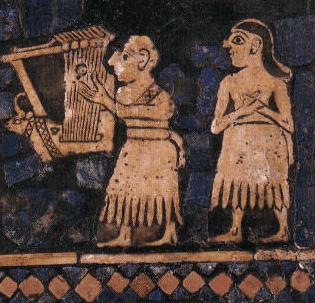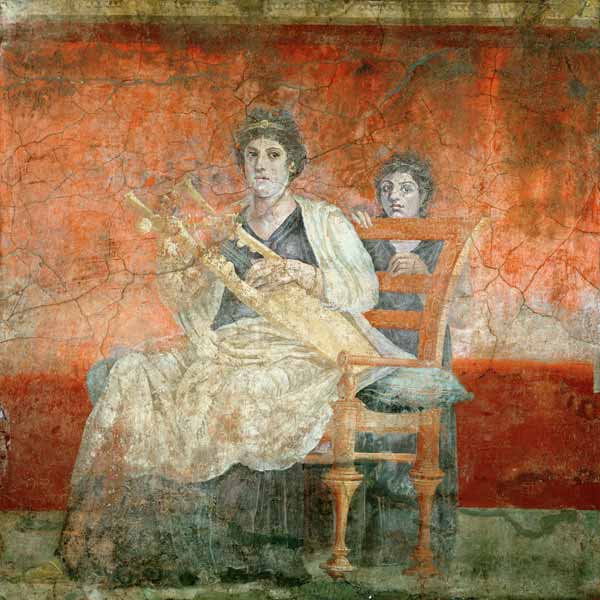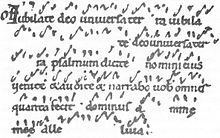


We have very little music that survives from ancient times. The earliest piece we know of is a fragment from the Hurrian people of Ugarit in Mesopotamia, honoring the moon goddess Nikkal. https://www.youtube.com/watch?v=7ZatnTPhYWc
We have many pictures from ancient Egypt, Greece, Rome, Mesopotamia, showing instruments being played, almost no actual music notation. This is a painting from a house in the Roman city of Pompeii, that was buried in the eruption of Mt. Vesuvius in 79 AD. 
The Seikilos epitaph is the oldest surviving complete musical composition, including musical notation, from anywhere in the world. The epitaph has been variously dated, but seems to be either from the 1st or the 2nd century AD. The song, the melody of which is recorded, alongside its lyrics, in the ancient Greek musical notation, was found engraved on a tombstone (a stele) from the Hellenistic town Tralles near present-day Aydın, Turkey, not far from Ephesus. It was a tribute from a man named Sekilos to his wife Euterpe. (Wikipedia)
https://www.youtube.com/watch?v=yYZmPLo9Ywc
|
Ancient Greek text Ὅσον ζῇς φαίνου |
Transliteration of Greek text hóson zêis, phaínou |
English translation While you live, shine |
As far as we can guess, most music in ancient times would have been monophonic, with instruments possibly doubling the voice, with perhaps a drone. Although we don't know for certain, we know that music originating in the Middle East, such as Palestine, would have been performed in this way. We have examples of very old styles of Jewish liturgical chant, where a leader sings a section, and it is then repeated by the congregation. This example is from the Mizrahi Jewish population from Iraq who originated with the Babylonian captivity of the Israelites (598-538 BCE). https://www.youtube.com/watch?v=ulEoW5eCNOU
Early Christianity, which started as a Jewish sect, would have had singing of the worship service in a similar manner, monophonically, with a leader alternating with the congregation, or everyone singing in unison. Here we see an example of old style chant from the Georgian Orthodox Church in Aramaic language (the language spoken by Rabbi Yeshua bin Yusuf (aka Jesus of Nazareth). Note how some people are singing a single note as a drone to support the soloist (probably the priest's daughter, as clergy can marry in the Orthodox Church).
We term the era from 476-1450 CE as the Middle Ages, because it is between the Ancient or Classical Period, and the modern history starting with the Renaissance.


Books were hand copied by monks and nuns, with the cost of an unornamented book was equivalent to a car. Ornamented books would have been fabulously expensive. Here is an example of a 12th-century German manuscript of poems and songs called Carmina Burana (Songs from the Monastery of Benediktbeuern.


Gradually, chant texts were marked with lines to show the rise and fall of pitch, but not exactly how high or low each pitch was in relation to to the next one. But this was only a mnemonic, and was not explicit enough without someone who knew the melody already.

Setting things on an X-Y type graph solved the problem of precision

The seven notes of the octave were given the letter names A-G.Since C was the most common note for major-type melodies, It was chosen as the most common marker on the grid.
https://www.youtube.com/watch?v=0OIDAc-zFkY
Different styles of chants for different purposes:
Melismatic settings have long, stretched out syllables with less text, providing a more tranquil mood. This example is the Christmas Gradual chant "Viderunt Omnes".
https://www.youtube.com/watch?v=EN73kO2_PZA
Syllabic chants have more text, often specific to specific days in the Church calendar, teaching the lessons of the day.
`An example of this is “Gloria Laus et Honor Tibi Sit” (Glory, Praise, and Honor Be Unto You” composed in 820 CE by a contemporary of Charlemagne, Theodulf, Bishop of Orléans.

Born to minor nobility in Western Germany, she was the tenth child, and was pledged as a tithe to the Church. Hiildegard suffered from ill health, and had visions which inspired her.
She entered the Benedictine monastery at Disibodenberg at age 8, and was the student of an anchoress (hermit) Jutta of Sponheim, who believed in treating the body very harshly. Jutta taught Hildegard reading, writing, herbalism, healing. A monk named Volmer, connected with the nunnery, probably taught Hildegard music, including notation.
After Jutta died in 1136, Hildegard was unanimously elected as magistra of the community by her fellow nuns.She founded two other monasteries, wrote music and poetry, the first morality play, painted, wrote books on medicine, herbalism, etc.
She was very strong and determined, even in the very male dominated society of medieval Europe. She and her nuns defied the church, and allowed the burial on convent ground of a man who they felt was unfairly excommunicated. As punishment, the bishop forbade them to sing during mass. For two years they obeyed. Finally, unable to contain herself, Hildegard wrote a polite letter, citing the Psalms.
Praise the LORD.
Praise God in his sanctuary;
praise him in his mighty heavens.
Praise him for his acts of power;
praise him for his surpassing greatness.
Praise him with the sounding of the trumpet,
praise him with the harp and lyre,
praise him with tambourine and dancing,
praise him with the strings and flute,
praise him with the clash of cymbals,
praise him with resounding cymbals.
Let everything that has breath praise the LORD.
Praise the LORD." (Psalm 150:1-6)
In the end, the bishop had to yield to her persuasive arguments. She was so well respected as a philosopher that the Pope deemed her writings suitable for preaching to men, including those going on Crusade.
The acceptance of public preaching by a woman, even a well-connected abbess and acknowledged prophet, does not fit the stereotype of this time. Her preaching was not limited to the monasteries; she preached publicly in 1160 in Germany. (New York: Routledge, 2001, 9). She conducted four preaching tours throughout Germany, speaking to both clergy and laity in chapter houses and in public, mainly denouncing clerical corruption and calling for reform.[81]
Many abbots and abbesses asked her for prayers and opinions on various matters.[1] She traveled widely during her four preaching tours.[82] She had several devoted followers, including Guibert of Gembloux, who wrote to her frequently and became her secretary after Volmar's death in 1173. Hildegard also influenced several monastic women, exchanging letters with Elisabeth of Schönau, a nearby visionary.[83]
Hildegard corresponded with popes such as Eugene III and Anastasius IV, statesmen such as Abbot Suger, German emperors such as Frederick I Barbarossa, and other notable figures such as Saint Bernard of Clairvaux, who advanced her work, at the behest of her abbot, Kuno, at the Synod of Trier in 1147 and 1148. Hildegard of Bingen's correspondence is an important component of her literary output.[84] (Wikipedia).
One of her famous hymns is "O Viridissima Virga" (Oh Greenest Branch), praising the Virgin Mary.
https://www.youtube.com/watch?v=zGjC8GnIHZg&t=2s
“O Viridissima Virga”—O Greenest Branch
1. O branch of freshest green,
O hail! Within the windy gusts of saints
upon a quest you swayed and sprouted forth.
2. When it was time, you blossomed in your boughs—
“Hail, hail!” you heard, for in you seeped the sunlight’s warmth
like balsam’s sweet perfume.
3. For in you bloomed
so beautiful a flow’r, whose fragrance wakened
all the spices from their dried-out stupor.
4. They all appeared in full viridity.
5. Then rained the heavens dew upon the grass
and all the earth was cheered,
for from her womb she brought forth fruit
and for the birds up in the sky have nests in her.
6. Then was prepared that food for humankind,
the greatest joy of feasts!
O Virgin sweet, in you can ne’er fail any joy.
7. All this Eve chose to scorn.
8. But now, let praise ring forth unto the Highest!
The question is: what distinguished sacred from secular music? It was determined by where music was performed, and in what language.
| Sacred | Secular |
|
Performed in Church |
Performed outside of Church |
|
Only in Latin |
Vernacular languages Sometimes Latin |
The Crusades
The First Crusade (1095–1099) was the first of a number of crusades that attempted to recapture the Holy Land, called for by Pope Urban II at the Council of Clermont in 1095. Urban called for a military expedition to aid the Byzantine Empire, which had recently lost most of Anatolia to the Seljuq Turks.
French nobles and knights came in contact with their more civilized Muslim enemies. And picked several concepts:
Chivalry—inspired by the Muslim code of warriors virtue, Futūwa
Lyric love songs—known in Arabic as muwaššaḥ, here's an example
https://www.youtube.com/watch?v=BCGzi9Wz8U0
When she started to walk with a swinging gait
aman aman aman aman
her beauty amazed me
aman aman aman aman
I have become prisoner of her eyes aman aman aman aman
her stem folded as she bent aman aman aman aman
O my promise, O my perplexity, who can answer my complaint about love and suffering but the beautiful one?
aman aman aman aman
about love and suffering but the beautiful one?
aman aman aman aman
MAP OF 12TH-CENTURY FRANCE

Southeastern France, known as Provence, on the Mediterranean Sea, was the point of sea contact with the Middle East. There they spoke a different language from that spoken in the North (the ancestor of modern French. That Southern language, known as Langue d’Oc, Occitan, or Provençal sounds more similar to Spanish. The word for "yes" in Provençal is "oc," so Langue d'Oc mean the language of "oc," as opposed to Old French which which was known as Langue d'Oui, or the language of "oui."
Inspired by the Middle Eastern examples, noblemen and commoners started writing lyric songs, and were known in Provence as troubadors, or in the North as trouvères. The concept of Courtly Love also derived from Islamic models. A knight or nobleman would focus on a lady as a chaste object of devotion, and dedicate his deeds of bravery to her. Another aspect, however, was forbidden love, à la Romeo and Juliet. Songs in which a man's best friend stands by while he is with his lover, watching for the dawn, hence "Dawn Songs." are common.
One of the most notable troubadors was Girault de Bornelh (c. 1138 – 1215). His song "Reis Glorios" is a Dawn Song.

|
Reis glorios, verais lums e clartatz,
Deus poderos, Senher, si a vos platz, al meu companh siats fizels ajuda; qu'eu no lo vi, pos la nochs fo venguda, et ades sera l'alba! Bel companho, si dormetz o velhatz, no dormatz plus, suau vos ressidatz; qu'en orien vei l'estela creguda c'amena.l jorn, qu'eu l'ai ben conoguda, et ades sera l'alba! Bel companho, en chantan vos apel; no dormatz plus, qu'eu auch chantar l'auzel que vai querren lo jorn per los boschatge, et ai paor que.l gilos vos assatge, et ades sera l'alba! Bel companho, issetz al fenestral e regardatz las estelas del cel! Conoisseretz si.us sui fizels messatge; si non o faitz, vostres n'er lo damnatge, et ades sera l'alba! Bel companho, pos me parti de vos, eu no.m dorm ni.m moc de genolhos, ans preiei Deu, lo filh Santa Maria, que.us me rendes per leial companhia, et ades sera l'alba! Bel companho, la foras als peiros me preiavatz qu'eu no fos dormilhos, enans velhes tota noch tro al dia. Era no.us platz mos chans ni ma paria, et ades sera l'alba! Bel dous companh, tan sui en ric sojorn qu'eu no volgra mais fos alba ni jorn, car la gensor que anc nasques de maire tenc et abras, per qu'e non prezi gaire lo fol gilos ni l'alba! |
Shining King, brilliance, light,
Precious friend, get to the window, Lovely, lovely friend, so rich my stay, Translation, C.E. Whitehead http://www.bu.edu/pusteblume/6/whitehead-translating-bornelh.htm |
https://www.youtube.com/watch?v=3BZlcJACkxA&t=113s
Richard Coeur de Lion-Richard the Lion Heart (8 September 1157 – 6 April 1199)
Even royalty were known as troubadors and trouvères. The famous warrior king, Richard I of England, wrote a number of songs. There are legends that when he was kidnapped and held for ransom in German on his way back from the Crusades, someone heard him singing the following song from a castle tower, and was able to arrange for his ransom. https://www.youtube.com/watch?v=9yvucNpRQxc

Effigy of Richard I of England in the church of Fontevraud Abbey
By Adam Bishop - Own work, CC BY-SA 3.0, https://commons.wikimedia.org/w/index.php?curid=17048652
Ja nus hons prisJà nus hons pris ne dira sa raison
Adroitement, sé dolentement non ;
Mais, por confort, puet-il faire chanson
Moult ai d’amis, mais povre sont li don ;
Honte en auront, sé por ma réançon
Sui ces deus yvers pris.
Ce savent bien mi home et mi baron,
Englois, Normant, Poitevin et Gascon,
Que je n’avoie si povre compagnon
Que je laissasse, por avoir, en prison.
Je nou lo dis por nule retraiçon,
Mais encor sui-je pris.
Jà nus hons pris ne dira sa raison
Adroitement, sé dolentement non ;
Mais, por confort, puet-il faire chanson
Moult ai d’amis, mais povre sont li don.
|
Never can a prisoner tell his mindNever can a prisoner tell his mind,
Openly, without sadness,
But, vehemently, he can write a song,
I have many friends, but poor are the gifts,
Shame on them, if to gather my ransom,
I am here for two winters.
They know well, my men and barons,
English, Normans, Poitevins and Gascons,
That I have no companion, no matter how poor,
That I would leave in prison without acting,
I am not criticising,
But I am still prisoner.
Never can a prisoner tell his mind,
Openly, without sadness,
But, vehemently, he can write a song,
I have many friends, but poor are the gifts.
|
Earliest Polyphony-Organum
Probably influenced by polyphonic folk musics, people started ornamenting Gregorian Chant by adding multiple parts. The earliest pieces we know comes from the 10th century
https://www.youtube.com/watch?v=EAdtlR1eTZs
https://www.youtube.com/watch?v=F5vqAU_EqG4
The Rise of Polyphony in the 12th Century

The 12th Century was a time of economic growth and technological innovation. Gothic architecture, such as the Cathedral of Notre Dame in Paris used the technique of flying buttresses to allow for tall buildings with thin walls that won’t topple under their own weight. This allowed for large stained-glass windows and big resonant spaces. Composers wrote music to match the space.
Composers such as Leonin (fl. 1150s — d. ? 1201) and Perotin (fl. ca 1200) took Gregorian chants and stretched them out to serve as the basis for polyphonic writing above them as ornamentation of chant. Usually the organum alternated with sections of monophonic chant.
Here is the Christmas introit (Entry processional) “Viderunt Omnes”
https://www.youtube.com/watch?v=EN73kO2_PZA
Here, Leonin stretches parts out, and puts on ornamental part on top
https://www.youtube.com/watch?v=_p9WQlyVPrA
Here is Perotin’s later version with three voices on top of the stretched out chant
https://www.youtube.com/watch?v=BdhKvj7BLXI
Pieces without a Gregorian chant cantus firmus become popular in the 13th Century.. They use the same triple meter patters known as the rhythlmic modes. Here is one such conductus. https://www.youtube.com/watch?v=ZHrteJ35TdY
Here is the same piece, adding the parts one at a time.
https://www.youtube.com/watch?v=Z9WMmspAe4c
The 14th Century
Ars Nova (The New Art)
Guillaume de Machaut 1300-1377

!4th-century composers continued to use the musical/poetic forms developed by the troubadors, but added polyphony in two and three parts. Guillaume de Machaut was a priest, composer, and director of church choirs, and is known for both sacred and secular music--including love songs. Here one secular example of a piece called a rondeau. The musical rondeau is typically a two-part composition with the form AB-aAab-AB , with all the "A" sections of the poem's structure set to one line of music, and all the "B" parts to another. When the words vary there is lowercase letter, uppercase letters indicate previous words are repeated, like in a refrain.
https://www.youtube.com/watch?v=0yi2MMtIimY
|
Puis qu'en oubli sui de vous, dous amis, |
Since I am forgotten by you, sweet friend, |
Francesco Landini (c. 1325 or 1335 – September 2, 1397)

A notable performer, composer, and instrument maker, details about his correct name are vague and confusing. However, it is well known that he was blind from childhood as a result of smallpox. He sang and played a number of musical instruments, including the lute, organ, and, very notably, a small hand-pumped organ played with one hand, called a portative organ. In the following video we see a performance of a famous dance piece, or ballata (French, ballade), "Ecco la Primavera" (Behold, the Springtime). The portative is played by the remarkable Chilean keyboard player, Catarina Vincens.
https://www.youtube.com/watch?v=tXPI8JfQBc4
| Ecco la primavera, Che’l cor fa rallegrare, Temp’è d’annamorare E star con lieta cera. Noi vegiam l’aria e’l tempo Che pur chiam’ allegria In questo vago tempo Ogni cosa vagheça. L’erbe con gran frescheça E fior’ coprono i prati, E gli albori adornati Sono in simil manera. Ecco la primavera Che’l cor fa rallegrare Temp’è d’annamorare E star con lieta cera. |
Spring has come apace Source: http://www0.cpdl.org/wiki/index.php/Ecco_la_primavera_(Francesco_Landini) |